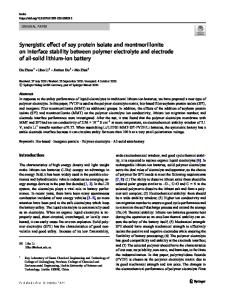Functionalized carbon dot nanoparticles reinforced soy protein isolate biopolymeric film
- PDF / 2,427,901 Bytes
- 10 Pages / 595.276 x 790.866 pts Page_size
- 83 Downloads / 433 Views
ORIGINAL PAPER
Functionalized carbon dot nanoparticles reinforced soy protein isolate biopolymeric film Shikha Rani1 · K. Dinesh Kumar2 · Saptarshi Mandal3 · Rakesh Kumar1 Received: 5 February 2020 / Accepted: 3 September 2020 © The Polymer Society, Taipei 2020
Abstract Amine and carboxyl functionalized carbon dots (CDs), i.e., citric acid polyethylenimine (CPI) and citric acid glycine (CCG) at different contents (0.05 to 0.5% w/w with respect to soy protein isolate (SPI)) were incorporated in glycerol plasticized SPI to produce CDs reinforced SPI films. Functionalized CDs were characterized by fluorescence spectroscopy and X-ray diffraction (XRD). The CDs reinforced SPI films were structurally, morphologically, and mechanically characterized by Fourier transform infrared (FTIR) spectroscopy, scanning electron microscope (SEM) and mechanical properties, respectively. Water uptake studies were also carried out for CDs reinforced SPI films. The results from FTIR study indicated shifting of amide II band from 1544 to 1530 cm−1 for CPI incorporated SPI and generation of a band at 1741 cm−1 for CCG incorporated SPI indicating unbounded –COOH groups of CCG with SPI. The tensile stress and tensile modulus of CPI, as well as CCG reinforced SPI films increased, indicating reinforcement effect of CDs on SPI film. The maximum tensile stress of 0.5% CPI and 0.15% CCG loaded SPI was nearly 38.03% and 42.85% higher than the maximum tensile stress of neat SPI film. Antibacterial activity of CPI and CCG reinforced SPI films against E. coli and L. monocytogenes were also studied but CCG and CPI incorporated SPI films did not show any inhibitory effect on above mentioned bacteria. This work will be helpful in fabricating functionalized CDs reinforced SPI film from the renewable resources with low water uptake and good mechanical properties. Keyword Soy protein isolate · Functionalized carbon dots · Reinforcement · Tensile properties · Biofilms · Water uptake
Introduction Synthetic plastics are major threat for environment in this era because of their immortal nature [1]. Increasing demand for plastic materials is only adding more and more load of synthetic plastic-based pollutants to environment. Researchers are trying to find out the appropriate alternative materials from starch, cellulose, chitin/chitosan, protein, etc. so that one time usages of synthetic plastics can be reduced [2–6]. Materials prepared from soy protein isolate (SPI) can be one of the replacements of synthetic based plastics. SPI being * Rakesh Kumar [email protected]; [email protected] 1
Department of Biotechnology, Central University of South Bihar, Gaya 824236, India
2
Department of Materials Science & Engineering, Indian Institute of Technology, Patna 801106, India
3
Department of Chemistry, Indian Institute of Technology, Patna 801106, India
a protein macromolecule is naturally degradable, biocompatible, easily available, and possesses a very good filmforming capacity. Due to these properties, SPI is a very suitable candidate for pa
Data Loading...











